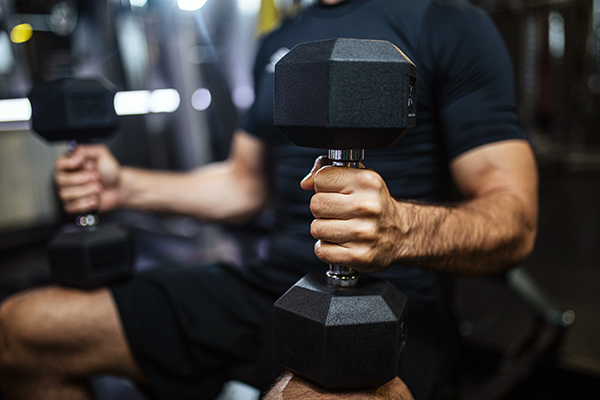A Beginner’s Guide to Weightlifting

When you decide to add strength training to your workout routine, beginner weight lifting tips are helpful. But once you get going, knowing how to progress can be tricky.
After all, most weightlifting newbies are unsure of their strength and, in turn, how to push it to its limits.
“How heavy a dumbbell should I choose? How many sets and reps should I do? When should I move up to heavier weights?”
For expert guidance, you can turn to BODi Super Trainer Joel Freeman — his weight-lifting programs, LIIFT4 and LIIFT MORE are efficient workout programs that combine weightlifting and calorie-burning high-intensity interval training (HIIT).
The moves are based on classic lifting techniques that let you isolate, stabilize, and focus each rep on the muscle group you’re working.
And every workout ends with a quick core routine for a full-body build and burn that leaves you shredded.
But first, let’s dive into some beginner weight lifting info, how to push yourself and your workouts to meet your individual goals.
Consider this your guide to awesome strength-training results!
How Do You Build Muscle?

Simply put, you get stronger by stressing your muscles, giving them enough time to recover, and then stressing them again.
Every time you place a demand on your body that’s heavier or harder than what it’s used to, you create microscopic tears in the worked muscle tissue.
Then, those tears heal and the muscle incorporates new structural and contractile proteins, coming back just slightly stronger and better able to handle even heavier loads.
Eventually, the exercise that was once incredibly challenging becomes easy and it’s time to increase the stress so that the process can happen again, and muscle growth continues.
The best way to get started is to pick up a weight that allows you to perform three sets of 10 reps with each exercise, so you’re lifting the weight 30 times, with a couple minutes of rest time between sets.
How Do I Progress in Weightlifting?
As you move out of beginner weight lifting status, you have three options regarding how to progress:
- First, you can lift the same number of sets and reps and just increase your weight. For example, if after a couple weeks of lifting, you can easily do three sets of 10 reps lifting 10-pound dumbbells, then pick up 15-pounders and do the same program, and then repeat this process.
- A second option is to increase sets and decrease reps, such as four sets of six reps. You would choose this option if you want to make big jump in weight, let’s say from 10 to 20 pounds, since you may not be able to lift 20 pounds more than six times. Also, the heavier your weight, the more rest you need between sets in order for your muscles to recover.
- A third option is to keep the same weight and do more reps, which may be your option if you only have one weight to work with.
If you’re working out in your home gym and don’t have multiple weights to choose from, you can still progress in a few different ways.
First, changing how you’re gripping the weight will engage different muscles.
You can also change the pace at which you lift, such as slowing down the eccentric phase of the exercise (i.e., when you lower the dumbbell in a bicep curl).
Lastly, you can decrease the amount of time you rest between sets.
What’s Your Weight-Training Goal: Muscle Strength, Endurance, or Size?

To keep your workouts progressing in the right direction, it’s important to be clear about your goal.
Here are recommendations for building muscle strength, endurance, and size, according to the Essentials of Strength Training and Conditioning, 4th Edition.
Muscle Strength
If you want to increase your muscle strength, you’ll want to perform low-repetition sets in which you’re lifting a weight that’s close to your one rep max (1RM), which is the most you can possibly lift in a given exercise with good form.
For example, you might perform two to six sets of six or fewer reps, lifting a weight that is 85 percent or more of your 1RM, with 2 to 5 minutes of rest between sets. If you’re able to lift seven or more reps, then you need to increase your weight.
Note: While determining your 1RM is a great way to understand your strength abilities, any testing should be performed under a certified trainer’s supervision.
Muscular Endurance
Muscular endurance is the ability of a muscle, or group of muscles, to perform continuously without fatigue. For muscular endurance, decrease your weight, up your number of reps, and reduce the amount of rest between sets.
For example, perform two to four sets of 12 to 20 reps using 50 to 70 percent of your 1RM, with 60 seconds of rest between sets.
Muscular Size
To build muscle size, or hypertrophy, you’ll want to increase your number of sets, but with heavier weights and lift as many reps as you can while maintaining good form.
Again, when you lose proper form, that is where you stop and make an adjustment. For example, perform three to six sets of six to 12 reps, using 67 to 85 percent of your 1RM, with 30 to 90 seconds of rest between sets.
With those heavier weights, you’ll need a bit more rest between sets. Once you hit 12 reps with good form, it’s time to pick up a heavier weight and go back to lifting 6 reps.
Speaking of bulk, let’s get real for a second: For women, there is a stigma around “getting bulky.” While women are slowly starting to embrace weightlifting, others worry that they will turn into the Hulk the second they pick up a dumbbell.
The truth is that most women can’t get bulky even if they wanted to since, compared to men, they have roughly 15 to 20 times lower testosterone — a hormone that plays a large part in bulking up.
So, while women can enjoy similar gains in muscle strength compared to men with weight training, most won’t notice a significant gain in muscle size due to genetics and hormones.
(Plus, if a woman has a lot of fat to lose, she may actually get smaller in her waist and thighs since lifting weights increases metabolism.)
As you experiment with these variables (weights, sets, reps, and rest between sets), remember they are interdependent, so if you change one, you need to adjust the others.
For example, if you lift a weight at the upper end of the range (85 percent of your 1RM), you’re going to perform fewer sets of fewer reps and take more rest than if you were to lift a weight at the lower end of the range (67 percent of your 1RM).
When to Pick Up a Heavier Weight
Once you consider a previously challenging workout easy, you are no longer stimulating muscle growth, you’re doing a recovery workout.
So what does “easy” actually feel like?
The best way to know when you’re ready to increase exercise stress — whether by lifting heavier weights, adding reps, or decreasing rest time between sets — is to track your workouts and focus on your form.
Stephen Graef, Ph.D., a sports psychologist at The Ohio State University Wexner Medical Center, suggests taking notes on your sets, reps, rest times, and how you feel for each workout. This way, you’re able to track your progress.
Focusing on your form can help you know when you’re ready for more. You should always use the heaviest weight that will allow you to perform all of your reps with good form.
Let’s say you lose proper form at the eighth rep of your bicep curl workout, don’t go any further and jot down a note that you lost form at the eighth rep.
When it’s time to do bicep curls again, see if you can perform more than eight reps with good form.
Once you’re able to accomplish all 10 reps with perfect form, and your last few reps of an exercise feel similar to your first few, it’s time to pick up a heavier weight.
Freeman says, “No matter your strength-training experience or what workout you’re doing, improving your form is a huge marker of progress.”
When learning new moves, he recommends looking at yourself in a mirror, or even filming yourself working out, so you can go back to analyze and improve your form.
In his own workouts, Freeman ups the weight based on his ability to get through his last rep without any help from a spotter. As soon as he can do that, he pushes himself even harder.
If you don’t have a spotter to keep yourself safe when you’re pushing yourself to your max, many trainers recommend progressing your weight when you can perform two extra reps during your exercise’s last two sets.
“If you can do two extra reps in your last set of a given exercise in two consecutive workouts, then you’re ready to progress,” says Trevor Thieme, C.S.C.S. “That’s called the ‘Two for Two Rule’.”
Again, going up in weight isn’t the only way to progress.
Thieme recommends trying out other options, such as decreasing the rest period, changing the grip of the weight so that different muscles engage, or moving from dumbbells to a barbell.
Are You Pushing Yourself Too Hard?

With all this pushing, it’s important to remember that it’s during the recovery process that your muscle tissues actually become stronger, bigger, and fitter.
There’s a fine line between pushing hard and getting the results you want versus pushing so hard that you actually hamper muscle growth.
So how do you know if you’re overtraining?
Physical symptoms include experiencing excessive fatigue, chronic soreness, more frequent injuries, and even illness. Mental symptoms include reduced motivation, irritability, and depression.
Again, this is where tracking your workouts comes in handy. If you lift significantly less weight for 2 weeks in a row, then you might be pushing too hard and not building muscle properly.
On recovery days, Freeman suggests stretching or foam rolling, or light cardio such as jogging, walking, or hiking.
One study showed that 20 minutes of light cardio on the recovery day helped women who lifted weights reduce muscle soreness.
Remember, every person is different. When you’re starting a beginner weight lifting regimen, it will take some time to understand the cues your body is telling you.
Graef says, “Over time, you’ll learn to listen to your body, and know when to push and when to pull back.”
Ready to start weight lifting? Check out all of the weight lifting programs and workouts available on BODi.